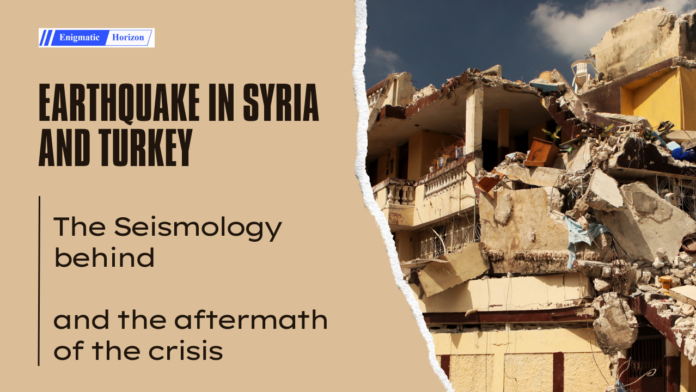On February 6, 2023, two 7.8 Mw and 7.5 Mw (moment magnitude scale) earthquakes struck southern and central Turkey, as well as northern and western Syria, with a time gap of nine hours.
As per reports by the seismologists, the 7.8 Mw earthquake was the strongest in Turkey since the 1939 Erzincan earthquake, and was of the same magnitude. Together, the earthquake of this time can be regarded as the deadliest seismic event in the history of modern Turkey and the deadliest in Anatolia since the 1268 Cilicia earthquake. In Syria, it was the deadliest since the 1822 Aleppo earthquake. It was the fifth deadliest earthquake of the 21st century, being felt over Egypt, Israel, Palestine, Lebanon, Cyprus, and the Black Sea coast of Turkey. There were at least 39,672 deaths and 1,08,068 injuries across Turkey. And thousands of people are believed to still be stuck in the wreckage of collapsed buildings.
Reasons behind the earthquakes:
A combination of several factors led to widespread destruction in both countries.
The location of the earthquake is within the area of a triple junction between the Anatolian, Arabian, and African tectonic plates. Turkey is one of the world’s most active earthquake zones. The earthquake is reported to have occurred due to the Arabian tectonic plate moving northward and crushing against the Anatolian plate.
Other reasons are the reliability of the buildings and the time of day that the earthquake occurred. It hit in the early morning when most people were asleep and had little opportunity to escape the collapsing buildings. Henry Bang, an expert in disaster management, said that making sure buildings in the area can stand up to earthquakes should be a top priority.
Shaking of these magnitudes in quick succession would pose a risk to any building, and a tragedy on this scale was not in any way inevitable, as experts underlined.
If the matter of building construction is considered, many questions arise, such as: is it the case that the two earthquakes were simply too violent for most buildings to survive or that the buildings were not up to modern construction standards, or was there any negligence on the part of the authorities? Turkey is still trying to understand the reason for so much damage to the country’s infrastructure in this earthquake, for which it was supposedly preparing for more than 20 years. Sinan Turkkan, a civil engineer and president of Turkey’s Earthquake Retrofit Association, stated, “Many buildings only received light to medium damage in the first quake but collapsed after the second one. According to official estimates, 6,000 to 7,000 buildings collapsed on Monday. However strong, no earthquake could have caused this much damage if all buildings were up to standard.” Most of the buildings that collapsed on Monday were constructed before the 1999 severe earthquake. Civil engineer Jonathan Stewart stated, “Typically, the columns and the beams are concrete and then there is kind of a masonry infill block inside these frames, which falls apart very quickly when the shaking begins.”
Dangers to life now and how to minimize them:
There are still many dangers to life in both countries. The nearly freezing temperatures in the regions are lowering the chance of survival for the alive as well. For those who became homeless, warmth and safe shelter were needed, along with food and clean water. Thousands of pregnant women are there as well. Trauma, grief, and loss of livelihood are some of the forthcoming dangers for the survivors. Preventative measures include public health measures, observation, outreach, screening, developing policies, etc. Amenable measures include reducing waits and harmful delays. Heavy lifting equipment and rapid access to sites are essential for reducing deaths for those trapped.
Turkish President Recep Tayyip Erdogan’s response to the disaster and potential calls for accountability regarding why so many buildings collapsed so quickly, will play a major role in his political career. This is a critical point for the country as it approaches the presidential election on May 14. The election result will have great effects on Turkey’s population, economy, currency, and democracy.
Syria, already destroyed by 12 years of war and terrorism, is the least prepared to deal with such a crisis. Its infrastructure is heavily worn-out, and the country remains under Western authority. So many people in the affected areas are already refugees or internally displaced people. Some of the areas in northern Syria that were damaged by the earthquake are controlled by Syrian rebels, the Syrian government, Jihadist forces, Kurdish forces, and Turkish-backed Syrian rebels and Turkish forces. Turkey itself is also a country already caught up in economic problems, and its military, economy, and politics have a major impact far beyond its borders.
However, for now, countries from around the world are sending aid and rescue teams to help with Turkey and Syria’s disaster relief efforts. This devastation is a call for all the other countries to deeply study and know their geographical placement and chances and types of probable disasters, and make all their infrastructural policies scientifically based on the results of the other two so that the damage can be minimized.
